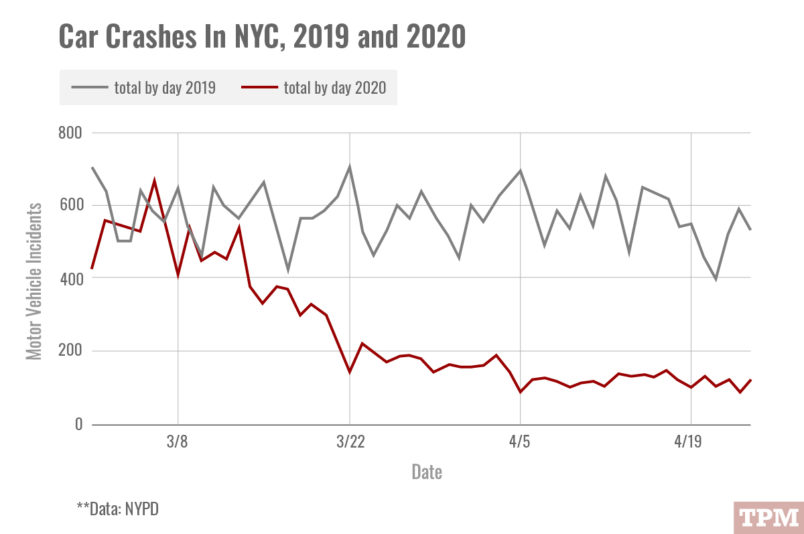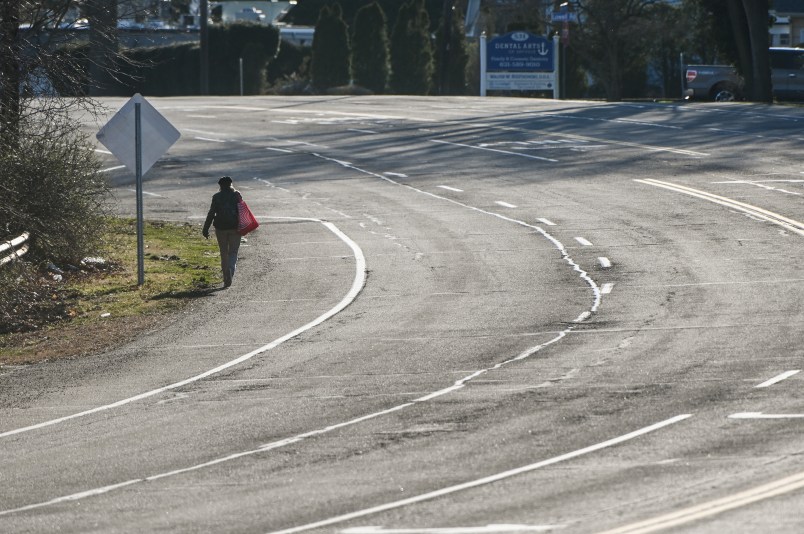History’s biggest social experiment is starting to yield weird results.
One is that the frequency of car accidents — and deaths and injuries associated with them — has plummeted across the U.S. as the country’s workforce stays home.
Data obtained by TPM shows that car accidents in New York City halved in March and April 2020, compared to the same timeframe in 2019.
A California study, run by the University of California-Davis’s Road Ecology center, found a similar decrease in car crashes.
Meanwhile, the state of Illinois recorded twelve fewer deaths to date than in 2019, while the city of Seattle’s 911 operators saw 31 percent fewer car accident calls in March and April of 2020 compared to the same period in 2019.

So, what does it all add up to?
What the data suggests, researchers told TPM, is that as lockdowns came into effect, fewer people traveling on the roads cut the frequency of car accidents roughly in half. With fewer cars on the roads, data also suggest that drivers’ average speed increased.
The New York City data records nearly 31,500 car accidents from March 1 to April 24, in 2019.
Over the same time period in 2020 the number was slightly less than half: 14,014.
The amount of people injured while driving in NYC also dropped accordingly — from 8,546 over the same timeframe in 2019, to 4,106 in 2020. Road deaths decreased year-by-year with 34 over the same time period in 2019, to 14 in 2020.
For the first time in my life, I wake up to the sound of birds outside my window — and I live by the FDR,” – Danny Harris, head of New York City’s walking, biking, and public transportation advocacy group Transportation Alternatives and a resident of the city, told TPM, referring to FDR Drive, a three-lane freeway running along Manhattan’s East Side.
Harris noted that as the frequency of car trips have gone down, speeding has dramatically increased as drivers face empty streets.
“If the number deaths have declined in comparison to what they were, speeding is up significantly,” Harris said. “We’re seeing a significant reduction in traffic and we’re seeing that camera violations are double what they were a month ago.”
UC Davis researchers found a similar pattern in California. Fraser Shilling, director of the university’s road ecology center, observed “statistically significant” increases in average traffic speed around the state since California Governor Gavin Newsom (D) put the state under lockdown.
Shilling catalogued the findings, based on California Highway Patrol data, in a report titled Impact of COVID19 Mitigation on California Traffic Crashes.
The report also noted that California went from recording an average of 500 fatal crashes each day to 200 under lockdown conditions.
The car fatality numbers are dropping as the country grapples with trying to determine the pandemic’s true death toll.
Statistics compiled by Johns Hopkins University put the number of people who have died of COVID at around 54,000, as of this writing. But the number fails to include so-called excess deaths — or people who died of the illness without ever being diagnosed or who died because of secondary effects of the pandemic, such as lack of access to emergency rooms or elective surgeries.
Sherry Towers, an epidemiologist at Purdue University, said it wasn’t clear yet what impact the reduced road fatalities would have on the overall death rate. It typically takes at least two years for the federal government to compile information from all the states and sort it into categories by cause of death.
But to Harris, the New York activist, the slowdown in traffic could present more of an opportunity to American cities. Milan and Paris have taken advantage of the change in traffic to begin large-scale installation of biking paths around their cities, as citizens are wary of public transit but accustomed to not using cars to get around.
“When Wuhan went back to normal, immediately they saw a doubling in driving, and you can take a look at images when they went back, highway roads were completely filled, and it was starting to impact air quality on the first day,” he said. “The other model is Milan, Paris, or San Francisco, where they’re thinking about it not just for immediate physical distancing needs, but long-term infrastructure improvements.”







I haven’t filled any of the cars in the family since mid-march. I don’t even remember when was the last time I saw gasoline at 1.78 a gallon, but I have refused to fill-up. Many of the countries most serious problems would fix themselves if gasoline cost 10 a gallon.
A decrease in car crashes during a national shutdown is “weird.”
I think you meant to type “likely.”
You get a lot fewer people yammering on their phones while they blast down the road, running late to that sales appointment or to pick up Krissy at the day care, and this is bound to happen.
Cant wait for Trump to take credit for improving roadway safety…
Anybody get the “shelter in place” rebate from their insurers ? Got $25.52 Shocker.